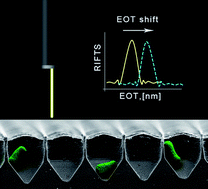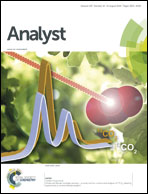Trap and track: designing self-reporting porous Si photonic crystals for rapid bacteria detection†
Abstract
The task of rapid detection and identification of bacteria remains a major challenge in both medicine and industry. This work introduces a new concept for the design of self-reporting optical structures that can detect and quantify bacteria in real-time. The sensor is based on a two-dimensional periodic structure of porous Si photonic crystals in which the pore size is adjusted to fit the target bacteria cells (Escherichia coli). Spontaneous bacteria capture within the pores induces measurable changes in the zero-order reflectivity spectrum collected from the periodic structure. Confocal laser microscopy and electron microscopy confirm that the Escherichia coli cells are individually imprisoned within the porous array. A simple model is suggested to correlate the optical readout and the bacteria concentration and its predictions are found to be in good agreement with experimental results. In addition, we demonstrate that sensing scheme can be easily modified to potentially allow monitoring of concentration, growth and physiological state of bacteria cells. This generic platform can be tailored to target different microorganisms by tuning the array periodicity and its surface chemistry for rapid and label-free detection outside the laboratory environment.


 Please wait while we load your content...
Please wait while we load your content...